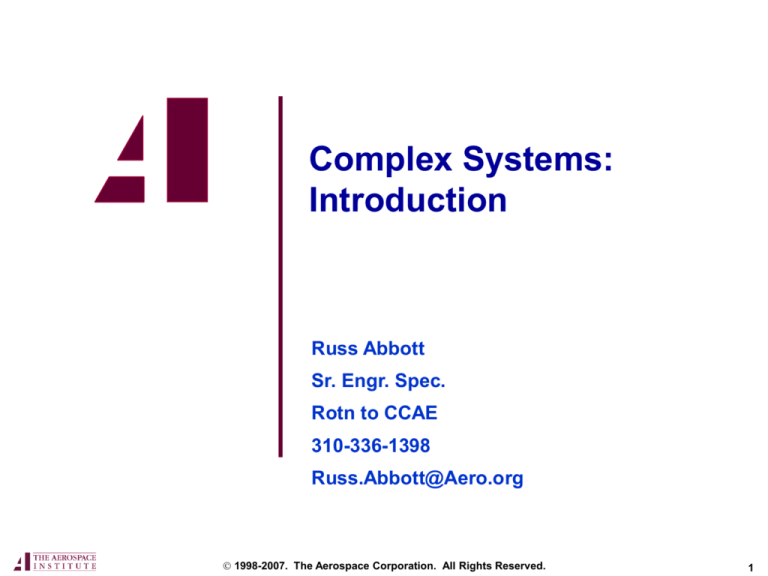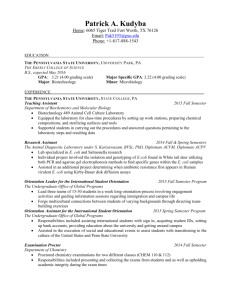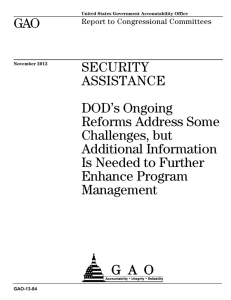
Complex Systems:
Introduction
Russ Abbott
Sr. Engr. Spec.
Rotn to CCAE
310-336-1398
Russ.Abbott@Aero.org
1998-2007. The Aerospace Corporation. All Rights Reserved.
1
A fable
• There was once a state in India that had too many snakes.
• To solve the problem the government instituted an incentivebased program to encourage its citizens to kill snakes.
• It created the No Snake Left Alive program.
– Anyone who brought a dead snake into a field office of the Dead
Snake Control Agency (DSCA) would be paid a generous Dead
Snake Bounty (DSB).
• A year later the DSB budget was exhausted. DSCA had paid
for a significant number of dead snakes.
• But there was no noticeable reduction in the number of
snakes plaguing the citizens of the state.
• What went wrong?
2
The DSCA mechanism
Receive dead snake
certificate. Submit
certificate to DSCA.
DSCA
What would you do if this
mechanism were
available in your world?
Start a snake farm.
Receive
money.
Submit a
dead snake.
Dead snake
verifier
3
Inside DSCA: how does the DSCA work?
repeat forever
Read the next input;
if (is-a-proper-DeadSnakeCert(input)
then Dispense-money;
end
function is-a-proper-DeadSnakeCert(x)
if (is-on-form-6942.4ax-rev-1(x)
and all-fields-are-filled-in(x)
and …)
then return true;
else return false;
4
Moral: unintended consequences
• The preceding is an example of what is sometimes called an
unintended consequence.
• It represents an entire category of (unintended and
unexpected) phenomena in which
– a mechanism is installed in an environment but then
– the mechanism is used/exploited in unanticipated ways.
• Once a mechanism is installed in the environment, it will be
used for whatever purposes users can think to make of it …
• which may not be the purposes for which it was originally
intended.
The first lesson of complex systems thinking is
that one must always be aware of the relationship
between entities and their environments.
5
Locomotion in E. coli
• [E. coli] movements consist of short straight runs, each lasting a
second or less, punctuated by briefer episodes of random
tumbling: each tumble reorients the cell and sets it off in a new
direction.
• Cells of E. coli are propelled by their flagella, four to ten slender
filaments that project from random sites on the cell’s surface. …
Despite their appearance and name (from the Greek for whip),
flagella do not lash; they rotate quite rigidly, not unlike a ship’s
propeller. …
• A cell … can rotate [its] flagellum either clockwise or counterclockwise. Runs and tumbles correspond to opposite senses of
rotation.
– When the flagella turn counter-clockwise [as seen from behind] the
individual filaments coalesce into a helical bundle that rotates as a unit and
thrusts the cell forward in a smooth straight run. …
– Frequently and randomly the sense of the rotation is abruptly reversed, the
flagellar bundle flies apart and the cell tumbles until the motor reverses
once again.
Harold, Franklyn M. (2001) The Way of the Cell: Molecules, Organisms, and the Order of Life, Oxford University Press.
6
Locomotion in E. coli
Shana Topp and Justin P. Gallivan,
“Guiding Bacteria with Small Molecules and RNA,”
J. Amer. Chem. Soc. May 2007.
http://pubs.acs.org/cgibin/sample.cgi/jacsat/2007/129/i21/pdf/ja0692480.pdf
7
Mechanism, function, and purpose in E. coli
• Cells [which happen to be] moving up the gradient of
an attractant … tumble less frequently than cells
wandering in a homogeneous medium: while cells
moving away from the source are more likely to
tumble. In consequence, the cell takes longer runs
toward the source and shorter ones away.
• How can a cell “know” whether it is traveling up the
gradient or down? It measures the attractant
concentration at the present instant and “compares” it
with that a few milliseconds ago.
• E. coli can respond within a millisecond to local
changes in concentration, and under optimal
conditions readily detects a gradient as shallow as
one part in a thousand over the length of a cell.
8
Mechanism, function, and purpose
• Mechanism: The results of physical
processes within an entity.
– E.g., the chemical reactions built into E.coli
that result in its flagella movements.
• Function: The effect on the
environment and the relationship
between an entity and its environment
as a result of the mechanisms.
– E.g., E. coli moves about. In particular, it
moves up nutrient gradients.
• Purpose: The consequence for the
entity of the change in its environment
or its relationship with its environment.
– E.g., E. coli is better able to feed, which is
necessary for self-persistence.
Socrates
Image from Wikipedia Commons:
http://commons.wikimedia.org/wiki/Image:Socrat
es_Louvre.jpg
Compare to Measures of Performance, Effectiveness, and Utility
9
How to drive a bacterium
Two ways:
• Fool with its sensing equipment
• Fool with its motor control.
The unintended consequence of
being a bacterium is the potential
for this sort of manipulation.
Shana Topp and Justin P. Gallivan
“Guiding Bacteria with Small Molecules and RNA”
J. Amer. Chem. Soc., May 2007.
http://pubs.acs.org/cgibin/sample.cgi/jacsat/2007/129/i21/pdf/ja0692480.pdf
10
Complex systems terms
• Emergence. A level of abstraction that can be described
independently of its implementation.
– Examples include E. coli motion through space (runs and tumbles),
which can be described independently of how it is brought about.
• Multi-scalar. Applicable to systems that are understood on
multiple levels simultaneously, especially when a lower level
implements the emergence of some functionality at a higher
level.
– E. coli is a good example of a multi-scalar system. Two of the
scales are the chemistry that result in the operation of its flagella
and the motion of the entity as a whole through space.
Isn’t that true of all systems?
We are in the business
of producing emergence
A system is a construct or collection
of different elements that together
produce results not obtainable by the
elements alone. – Eberhard Rechtin.
11
• NetLogo (http://ccl.northwestern.edu/netlogo/) describes itself as “a
cross-platform multi-agent programmable modeling environment …
for simulating natural and social phenomena.”
• It is produced by the Center for Connected Learning and ComputerBased Modeling at Northwestern University.
• It is implemented in Java.
• Version 4.0 was released September 2007.
• It’s free to download, but it’s not open source.
• It produces executable models that run both as applications and as
applets.
• It has a large library of models, which also run as both applications
and applets.
12
Try it out
File > Models Library > Termites
Click Open
13
Three tabs.
Interface:
run the model.
To run most
models, press
setup and then go.
Information:
documentation
about the model
Procedures:
the model in
NetLogo code
14
15
Learning Objectives
1. Learning Objective 1
(What it is 1)
2. Learning Objective 2
(What it is 2)
3. Learning Objective n
(What it is 3)
16
Outline of Presentation
• Topic 1
–
–
Duration
(min)
MTS
LO 1
nn min
TBD
LO 2
n.nn hr
TBD
LO n
nn min
TBD
Sub topic 1.1
Sub topic 1.2
• Topic 2
–
–
Learning
Objective
Sub topic 2.1
Sub topic 2.2
• Topic 3
17
Session Materials
(This the material body)
• Instructor’s charts
• Items the instructor would like to use:
–
–
–
–
–
–
–
–
“Show and Tell” items like hardware
Video tapes
Case studies
Relevant recent news items
Quizzes
Group work, problem solving
Instructor led exercises
Etc..
• PowerPoint Notes Page -- mandatory
– Used to capture acronyms – always do this!
– References
– Speaker's notes (optional)
• Think about the density of information given the learning
objectives and time you have for the session
– Ensure you meet the learning objectives
– You don’t need to tell everything you know
18
Session Material
(Illustrations)
Provide illustration of the system. Use one that isn’t proprietary. Simply,
redraw, change, to make one without copyright issues.
We’d like material that is free of copyright or proprietary issues.
Use Microsoft clip art or Aerospace repository of space illustrations (See
the Corporate Communication web site)
As a last resort, mark the
diagram if the information came from somewhere else. Determine if that
organization would allow us to use the diagram with their permission for a
course.
19
Key Considerations
• These considerations may be:
–
–
–
–
–
Organizational – remember to involve x, y, z organizations
System level – interfaces and trade space
Challenge oriented – risk, failures
Lessons learned, best practices, conventional wisdom, etc.
Others
20
Final Briefed Slide
(Choose one of the styles below)
• This chart can be a summary, wrap-up, way forward or
conclusions chart
• Summary of main learning points
– Almost the inverse of the learning objectives chart
• Wrap-up
– Gives an overview of what was covered
• Way-Forward
– Useful for briefings showing plans
• Conclusions
– Useful for sessions that derive qualitative or quantitative solutions
21
Reference Material
(Not briefed, but pointed to in the session)
22
Tools
• Identify Aerospace tools or other tools essential to do the
work.
• Identify organizations or POCs as you think make sense
23
Session References
• List key document and web references that would help
course participants dig deeper into the topic
– Try to use Aerospace material (TOR, ATM, Crosslink, etc.)
– Symposium papers
• One page is usually sufficient
24
Session Resources
• List resources that can help participants understand or
apply the work to their problem set
– Aerospace organizations
– Professional societies
– Customer groups
• Resources may be organizations, tools, facilities, people and
or other courses
25
Case Study Material
(Optional – based on session
and course design)
• If Case Studies are useful to illustrate points they can be
added as additional briefing material or for student use after
the course
• For inclusion in the session, various case studies may be
added to accommodate various instructors (instructor 1
knows case study 1, not 2; instructor 2 knows case study 2,
not 1)
• For inclusion for student use they should stand on their own
26
Student Reinforcement
(Optional – based on session
and course design)
• This is used to reinforce key learning points
• It may be part of the session materials and used by the
instructor or left as an exercise for the students to complete
• Examples include:
–
–
–
–
–
Quiz
Matching
Fill in the blank
Multiple choice
Essay
27








